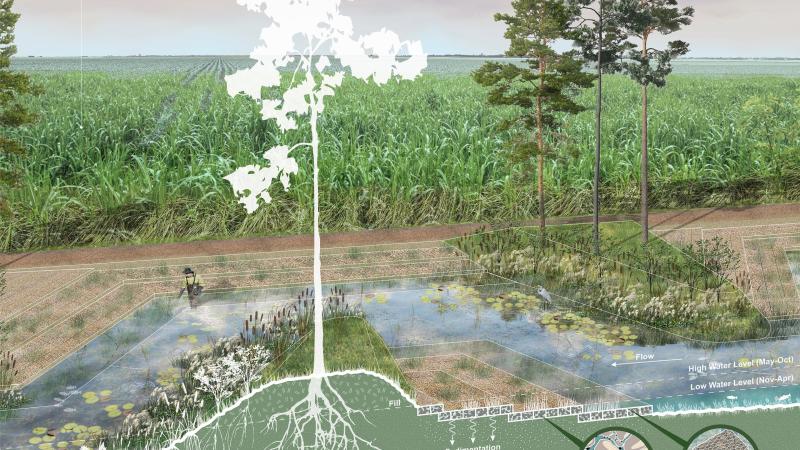Haobo Sun Wins 2021 OCASLA Student Merit Award
The MLA alum received the 2021 Student Merit Award from the Ohio Chapter of the American Society of Landscape Architects in recognition of his Directed Research project.

Haobo Sun Wins 2021 OCASLA Student Merit Award
Haobo Sun, a Master of Landscape Architecture alum (MLA ’21), received the 2021 Student Merit Award from the Ohio Chapter of the American Society of Landscape Architects in recognition of his Directed Research project, In Pieces, Augmenting Ecosystem Capacity in Everglades Agricultural Area. Sun’s project investigates using micro-wetlands to improve the Comprehensive Everglades Restoration Plan, reimagining its hydrological connections to the Everglades and Lake Okeechobee.
In Pieces, Augmenting Ecosystem Capacity in Everglades Agricultural Area
Currently, land in the Everglades is being lost every day because of the disconnection of the Everglades from its original freshwater source, Lake Okeechobee. This disconnection began with the draining of the Everglades in the late 19th century and has been exacerbated by agricultural and urban development in the region. In 2000, the State of Florida released the Comprehensive Everglades Restoration Plan (CERP) with the ambitious aim to restore the Everglades. However, CERP’s method is to construct a 10,500-acre, 23-feet-deep reservoir to store 240,000 acre-feet of water for controlled distribution into the Everglades. While water may be restored, the reservoir itself does not allow for any aquatic ecosystems. Many scholars are concerned that CERP’s singular focus on meeting water supply needs may result in decreasing attention to investments in broader ecosystem restoration.
As a landscape architect, I am interested in using design to challenge and synthesize the professions of ecology and hydrology. My project builds on existing work done by CERP to strategically consider alternatives to how a reservoir might be created and where it could thrive. This project investigates land design strategies for systematically augmenting the storage, distributional, and ecosystem capacity on a small portion of the agricultural area between Lake Okeechobee and Everglades that is currently slated to be replaced by the CERP reservoir via eminent domain. Rather than taking a monolithic approach to reservoir creation, my project takes a distributed approach, creating a network of micro-wetlands, while allowing farmers to maintain a much higher percentage of their land. The project results in a reservoir in pieces.
Media Gallery




To figure out a potential wetland network, geographic data was overlapped to pinpoint the areas with the highest priority. As treatment wetlands need to be built on uplands to avoid contamination to lower land fields and ecosystems, I began by identifying the most up-land sections in each parcel.
Wetland sizes vary according to local conditions. For instance, upland pieces on adjacent parcels can be used to form wetland chains. The upland wetland pieces will be larger than the downstream wetland pieces because upland wetland pieces will be necessary to purify water for all downstream ecosystems. Where possible, the largest wetlands cells are located adjacent to local highways to increase their visibility, acting as a public demonstration to help raise awareness of sustainability efforts within the Everglades ecosystem.
Media Gallery





A zig-zag, chicane form allows for prolonged water flow through each wetland cell. Gabion blocks are used to reinforce the chicane, capture sediment, and prevent soil erosion. Native aquatic plants are selected for wetlands based on water level, including submerged marsh vegetation, floating vegetation, emergent vegetation, and hydric soil vegetation.
The project produces 270 micro-wetland cells. Each wetland cell only occupies 1.1%-6.8% private of land in each parcel but adds up to 1,379 acres of proposed wetland. These wetlands increase the local biodiversity and have the ability to remove contaminants from surrounding agricultural fields. Most importantly, water will be purified before being sent downstream to the Everglades’ ecosystem. Migratory birds’ habitats will also be recreated as native plants will be planted, including up to 15,000 trees. During flooding occasions, these wetlands will also provide resilience for local agricultural fields by absorbing the water.
Media Gallery




